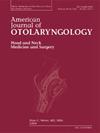Comparative outcomes between endoscopic and microscopic approaches in pediatric type-1 tympanoplasty
IF 1.7
4区 医学
Q2 OTORHINOLARYNGOLOGY
引用次数: 0
Abstract
Objectives
Type-1 tympanoplasty is a surgical procedure employed to repair the tympanic membrane, when ossicular reconstruction is not required. Historically, this was performed via a microscopic approach utilizing either a transcanal, endaural, or postauricular incision. Recently, there has been a growing shift toward the use of transcanal endoscopic ear surgery (TEES), eliminating the need for an endaural or postauricular incision. This study seeks to evaluate and compare outcomes between TEES and non-TEES type-1 tympanoplasty in a pediatric population, specifically tympanic membrane closure rates and post-operative audiometric results.
Methods
A retrospective review of all pediatric patients who underwent type-1 tympanoplasty at a tertiary care hospital between 2016 and 2020 was performed. Differences in tympanic membrane perforation closure rates and audiometric results between patients who underwent TEES vs. non-TEES were tested using Fisher's Exact and Mann-Whitney U tests. Logistic regression with stepwise selection and linear regression were used to compare factors among groups.
Results
118 patients underwent type-1 tympanoplasty (85 TEES, 33 non-TEES). Rate of closure was higher for patients who underwent TEES (91.76 %, 78/85) compared to non-TEES (69.7 %, 23/33) (Fisher's exact p = 0.006). Patients who underwent TEES had a greater reduction in post-operative PTA (median = −9 dB, IQR = −15 to −3 dB, n = 74) than those who underwent non-TEES (median = −5 dB, IQR = −11 to 3 dB, n = 31) (Mann Whitney p = 0.015).
Conclusion
In the study population, closure rates and audiometric outcomes were superior in patients who underwent type-1 tympanoplasty using TEES compared to non-TEES.
Level of evidence
III.
儿童1型鼓室成形术的内窥镜和显微镜比较结果
目的1型鼓室成形术是一种在不需要重建听骨的情况下修复鼓室膜的手术方法。从历史上看,这是通过显微镜入路进行的,利用经鼻、硬脊膜或耳后切口。最近,有越来越多的转向使用经鼻内镜耳部手术(tee),消除了对硬膜或耳后切口的需要。本研究旨在评估和比较儿科人群中tee和非tee 1型鼓室成形术的结果,特别是鼓膜闭合率和术后听力学结果。方法回顾性分析2016年至2020年在某三级医院行1型鼓室成形术的所有儿童患者。采用Fisher’s Exact和Mann-Whitney U检验,对接受tee与未接受tee的患者鼓膜穿孔闭合率和听力学结果的差异进行了检测。组间因素比较采用逐步选择和线性回归相结合的Logistic回归。结果118例患者行1型鼓室成形术(tee 85例,非tee 33例)。接受tee治疗的患者的闭合率(91.76%,78/85)高于未接受tee治疗的患者(69.7%,23/33)(Fisher精确p = 0.006)。接受tee的患者术后PTA(中位数= - 9 dB, IQR = - 15至- 3 dB, n = 74)比未接受tee的患者(中位数= - 5 dB, IQR = - 11至3 dB, n = 31)有更大的降低(Mann Whitney p = 0.015)。结论在研究人群中,使用tee的1型鼓室成形术患者的闭合率和听力学结果优于非tee患者。证据水平ii。
本文章由计算机程序翻译,如有差异,请以英文原文为准。
求助全文
约1分钟内获得全文
求助全文
来源期刊

American Journal of Otolaryngology
医学-耳鼻喉科学
CiteScore
4.40
自引率
4.00%
发文量
378
审稿时长
41 days
期刊介绍:
Be fully informed about developments in otology, neurotology, audiology, rhinology, allergy, laryngology, speech science, bronchoesophagology, facial plastic surgery, and head and neck surgery. Featured sections include original contributions, grand rounds, current reviews, case reports and socioeconomics.
 求助内容:
求助内容: 应助结果提醒方式:
应助结果提醒方式:


